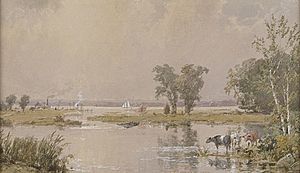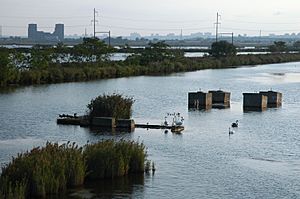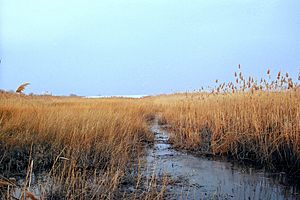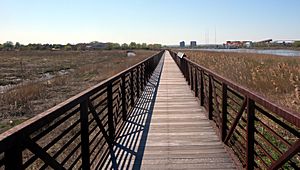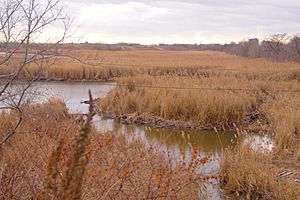New Jersey Meadowlands facts for kids
The New Jersey Meadowlands, also known as the Hackensack Meadowlands, is a large area of wetlands in northeastern New Jersey. It's just a few miles west of New York City. The Hackensack River flows through this important natural area.
For a long time, the Meadowlands were known for being a place where a lot of trash was dumped. People also caused other environmental problems there. Today, many projects are working to clean up and protect the remaining natural areas.
Contents
Where are the Meadowlands?
The Meadowlands stretch along the Hackensack and Passaic Rivers. These rivers flow into Newark Bay. Smaller streams like Mill Creek and Berrys Creek also join the Hackensack.
The Meadowlands include about 8,400 acres (34 square kilometers) of open, undeveloped land. There are also developed areas that were once part of the wetlands. This region covers parts of many towns, including Kearny, Secaucus, and East Rutherford.
A Look Back: Meadowlands History
Before European settlers arrived, the Meadowlands were covered with Atlantic white cedar forests. Early Dutch settlers cleared these forests. They also built dikes to drain the land. This created "meadows" where they grew "salt hay" for their animals. That's why the area became known as the "Meadows."
Later, the Meadowlands became known for being a place where lots of trash was dumped. This caused many environmental problems over many years.
How Humans Changed the Meadowlands
For centuries, people thought the Meadowlands were just empty, useless land. Because of this, humans changed the area in many ways. Here are some of the main changes:
- Using Natural Resources: People used to fish and hunt here. They also cut down cedar trees. Farmers harvested "salt hay" for animal feed. Over time, all the forests were cut down. The dikes broke, farming stopped, and pollution increased.
- Changing Water Flow: People dug drainage canals. They also made the Hackensack River deeper for boats. This allowed salty ocean water to flow into areas that used to have fresh or slightly salty water. This changed the natural environment and harmed the ecosystem.
- Building and Developing Land: New land was created by dumping garbage. Material from digging up riverbeds was also used. Some of the dirt from building the World Trade Center in New York City was even used here in the 1960s.
- Pollution and Waste: Different kinds of waste were dumped in the Meadowlands, both legally and illegally. During World War II, military waste was dumped. Even rubble from London after "the Blitz" was brought here. After the war, people continued to use the marshes for dumping civilian trash. They saw the marshes as "wastelands" that were not good for anything else.
Berrys Creek became very polluted with chemicals like mercury and PCBs. Some nearby industrial sites were even named "Superfund" sites, meaning they needed a lot of cleanup. The opening of the New Jersey Turnpike in 1952 also led to more environmental problems.
The Meadowlands Sports Complex, which has stadiums and a racetrack, was built in the Meadowlands starting in the 1960s.
Protecting the Meadowlands Today
The New Jersey Meadowlands are very close to the busy New York metropolitan area. This makes protecting such a large wetland a challenge. However, in 1969, the New Jersey Legislature created the Hackensack Meadowlands Development Commission. This group was formed to deal with both economic and environmental issues in the area.
This commission was in charge of approving building projects. It also managed landfill operations and oversaw projects to clean up and protect the environment. In 2015, this commission joined with the New Jersey Sports and Exposition Authority.
Efforts to Save the Environment
Even with all the past environmental problems, the Meadowlands are home to many types of fish, crustaceans (like crabs), and mollusks (like snails). They are also a very important place for birds.
The U.S. Environmental Protection Agency has provided money to help protect the Meadowlands. They also help organizations that study the animals and their environment. This ecosystem is delicate, and many waterfowl and other animals need it to survive. Richard W. DeKorte Park in the Meadowlands is a great place for bird watching, especially to see migratory waterfowl.
Images for kids


